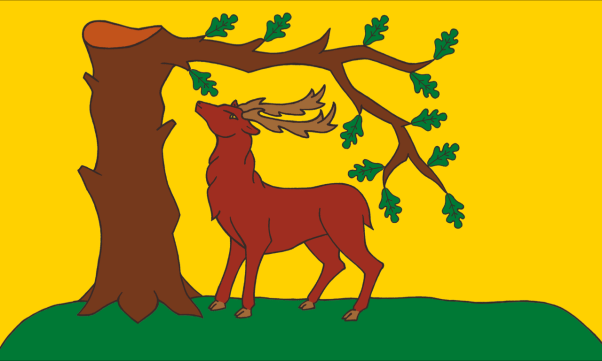
Berkshire’s flag was registered on February 27th 2017 following declarations of support from twenty-four local organisations, backed by the Lord Lieutenant of Berkshire, James Puxley. The flag features the traditional hart (stag) and oak theme associated with the county for several centuries, which appears on the badges, emblems and logos of a large number of county organisations.
The hart and oak refer generally to the forestlands of Berkshire and specifically to the legend of a late 14th century royal huntsman named Herne The Hunter. Legend has it that after various nefarious deeds by his jealous rivals, this one time favourite of the king was dismissed from royal service and distraught, he hanged himself from an oak tree which was then struck by lightning. The hart is “one of the manifestations of his restless spirit” and, according to Michael Drayton’s poem of 1627, a banner with this badge, or something very like it, was carried by the men of Berkshire at the Battle of Agincourt “Barkshire a Stag, vnder an Oake that stood,”. A video about the history and symbolism of the Berkshire flag is available here
Research conducted by Brady Ells, located and identified a seal used by the former Berkshire County Council before its formal acquisition of arms in 1947, which depicted the hart and stag emblem, in both monochrome

and coloured versions

, where a naturally brown stag, stands under a similarly naturally coloured, oak tree, with leaves and surrounding grass, set against a field of gold. The latter colour perhaps being a reference to Berkshire’s status as a “Royal County”, owing to the presence there of the principal royal residence, Windsor Castle. The seal is present on this 1912 image of the commemorations for the royal visit to Hungerford, affixed to the sign over the street
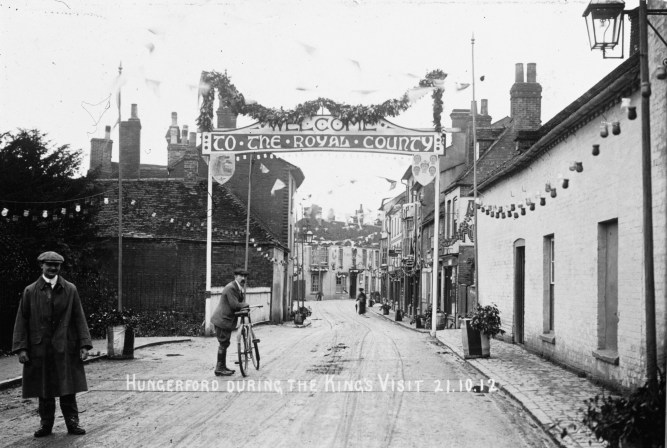

where the light coloured background against which the hart and oak are placed, is evident.
The specific colours of the county seal also appeared on the engines of the county fire service


and on this badge

of the county bowling team for their 1950 tour of Somerset.
This traditional depiction, initially fashioned to fly as a flag
by Brady Ells and later modified by the Flag Institute as above, for inclusion in the registry, maintains the resonant local theme, steeped in Berkshire history and culture, as evidenced by many further examples of the emblem in use in the county. The harts found in the county, known as ‘royal stags’, have twelve points on their antlers; this is reflected in the realisation of the deer shown on the flag.
The combined hart and oak has been used as a regimental badge by the Royal Berkshire Militia

and the same combination was found on the badge of Berkshire constabulary
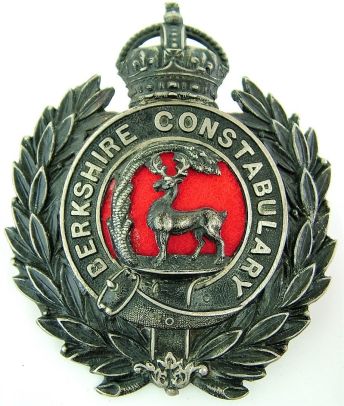
In 1947, the council received a formal award of arms

where the hart and oak featured as a crest.
 The trenchant Berkshire motif is in use today across the county, examples include;
The trenchant Berkshire motif is in use today across the county, examples include;
Berkshire Local History Association  ;
;
Berkshire Archery 
Berkshire Federation Of Women’s Institutes  ;
;
Berkshire Scouts  ;
;
Berks and Bucks Football Association  ;
;
Berkshire Cricket  ;
;
Berkshire Rugby  ;
;
Berkshire Bowling associations  ;
;
Berkshire Table Tennis Association  ;
;
Reading FC – Berkshire Wanderers  ;
;
Berkshire Schools Athletic Association

Berkshire Lieutenancy
Berkshire small Bore Rifle and Pistol Association features the stag alone, without the usual encompassing oak branch

In early 2017, realising that their county was one of only six in England without a registered flag, a number of Berkshire organisations threw their weight behind a campaign to see the traditional hart and oak, in original colours, registered as the Berkshire county flag. A total of twenty-four county bodies, from across the county
supported this move and with the subsequent sanction of James Puxley, the Lord Lieutenant

and Victoria Fishburn, the High Sheriff,

the design was duly registered as the county flag. The supporting organisations were;
Berkshire Archaeological Society
Newbury & District Agricultural Society
Abingdon Area Archaeological and Historical Socirty
Goring Gap Local History Society
Maidenhead Archaeological & Historical Society
Stanford in the Vale and District Local History Society
Friends of the Windsor and Royal Borough Museum
Royal County of Berkshire Bowling Association
Didcot & District Archaeological & Historical Society
Twyford And Ruscombe Local History Society
Hungerford Historical Association
The notion of deploying the county’s long associated emblem as a flag had first been mooted by David Nash Ford of the Royal Berkshire History website, who created a white and blue bicolour bearing a golden silhouette of hart and oak across the two bands

The overall design was loosely based on the Welsh national flag and the neighbouring Buckinghamshire flag (and county council arms) which both have depictions of animals overlaid over a bi-colour field. The colours of blue, gold (yellow) and white were taken from the shield on the former council arms
 and were further seen as representing the River Thames and the county’s chalk hills.
and were further seen as representing the River Thames and the county’s chalk hills.
This design was well received in some quarters, but also encountered opposition; the design breaks the heraldic “rule of tincture” (defined in point 3 of the Flag Institute’s recommendations on good flag design ) by placing a yellow charge partially on a white background, making it less visible from any distance. Additionally, the particular form of the central emblem, as lifted from the badge used on a cap by county regiments,

created a curve in the composite tree and stag emblem that led to criticisms that it resembled a letter “C”; this misled some people who thus made no association with Berkshire! In any case, as a novel design, the proposal could only be registered as the winner of a competition or other selection process and the pre-existing traditional arrangement made this novel realisation unnecessary.
Another strong contender for the county flag on traditional grounds, was the county’s other recognised emblem, the Uffington white horse
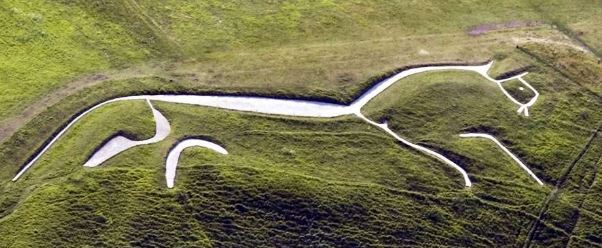
, which was first deployed as a flag

by the Friends of Berkshire in the 1980s. The design bears the image of the horse produced by removing sections of green turf, to reveal the white chalk below.
The estimated three thousand year old chalk carving certainly has a long association with the county and has been deployed as a badge

by the Berkshire Yeomanry

The emblem has appeared on buttons
and as a patch

Unsurprisingly, with its ancient origins, the device has also been favoured as insignia by county based archaeological concerns and local family history society
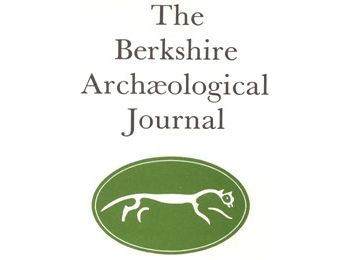
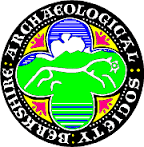


The Uffington horse is also found often in the badges of local sports teams and league

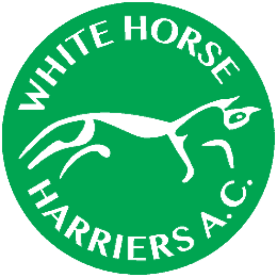
Of particular note is the adaptation of the Uffington horse by the West Berkshire Racing Club

located in Newberry.
The horse also appears in the arms of two local councils
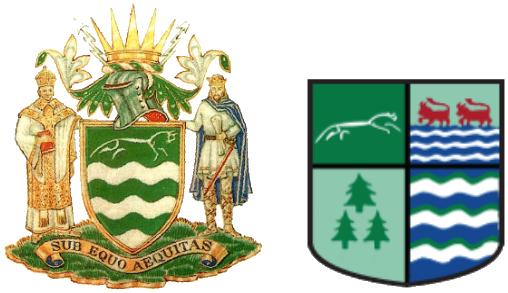
and features in the logos of a community bus service

a county brewery

and a school in the county, located in Reading

With its ancient stylisation the emblem is strikingly distinct and unique to the county

Ultimately however, the hart and oak was a more entrenched county symbol, with a much longer recognition and usage as a representation of Berkshire and with its 1627 poetic reference, also recorded as such in the written word.
Following its registration the flag was officially raised at the Berkshire county show, Newbury, on September 17th, 2017.

Both the county’s Lord Lieutenant James Puxley whose sanction had secured the flag’s registration and High Sheriff, Sarah Scrope,

were in attendance.
The county flag flies over the entrance to the Newbury Showground
took centre stage at a meeting of one of its most stalwart supporters, Berkshire Archaeological Society
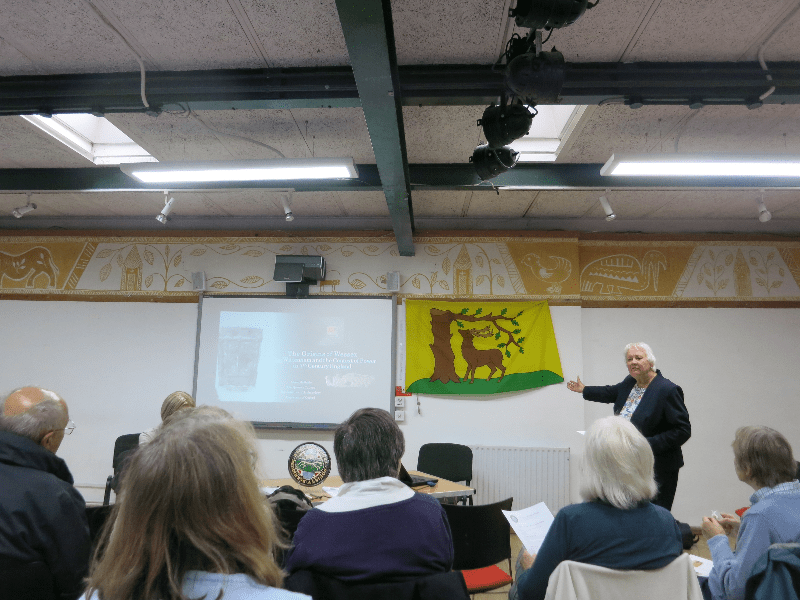
and has been raised over Saint Andrew’s Church, Sonning
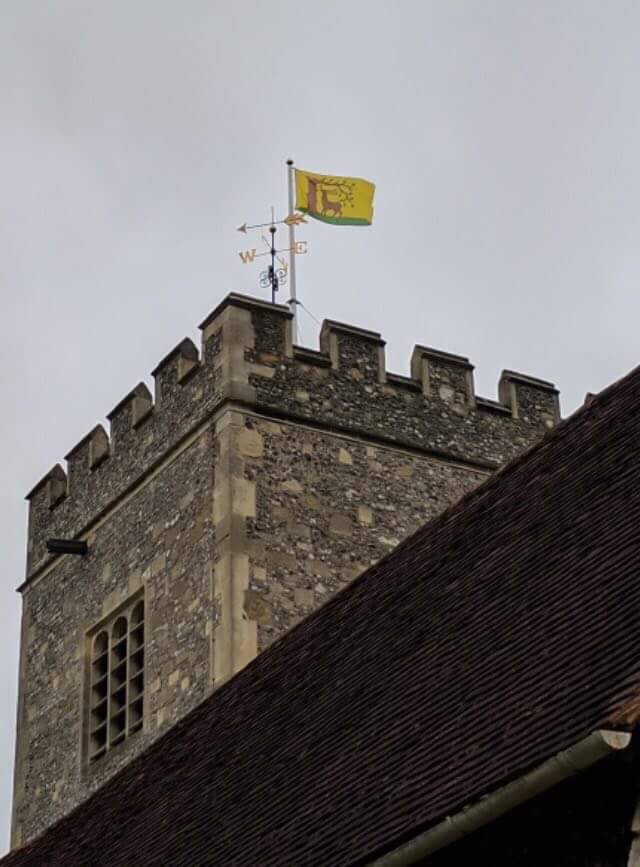
The Berkshire flag was presented, below, by members of one of its supporting groups, Project Purley, at the Royal Berkshire Regiment Memorial at Ploegsteert near Ypres

and displayed beside the graves of fallen Berkshire soldiers
The flag also flew at the hotel the group stayed at
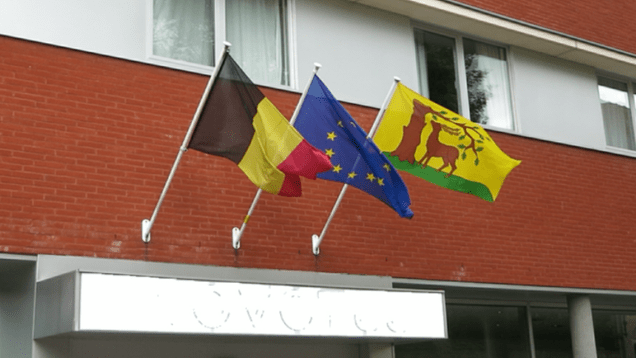
The flag has subsequently been taken up by fans at Maidenhead football club
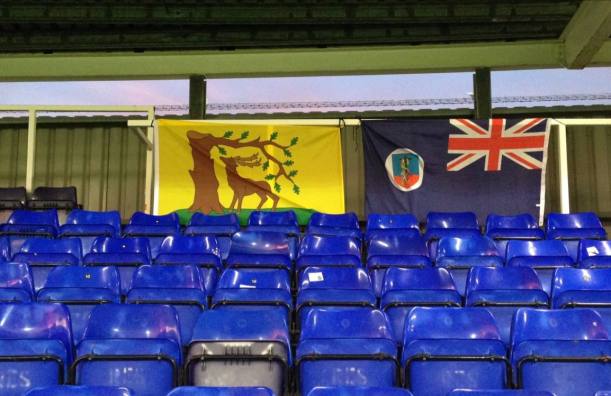
and the county team participating in the modern pursuit of “Airsoft”
The flag is seen here

wielded at the Reading Festival, held in the county and is presented here
as a tattoo! Below, Tom Hodgson on Toubkal,
the highest point in the Atlas Mountains (estimated at 4,167m) with his Berkshire county flag.
Prior to registration a “flag”,

based upon the logo of the former Berkshire County Council,

itself derived from the above council’s coat of arms,
 which were novelly created in the twentieth century, was commercially available. This design both lacked any artistic merit, a true armorial banner of the arms would have looked something like this
which were novelly created in the twentieth century, was commercially available. This design both lacked any artistic merit, a true armorial banner of the arms would have looked something like this

and was also devoid of the centuries long tradition enjoyed by the hart and oak emblem. Additionally, being essentially a white piece of cloth bearing some markings, the design is not a successful one for flag use, being quite indistinct against cloudy skies. This logo flag has never been the Berkshire county flag.
The county flag flew over Parliament Square, Westminster

along with other county flags
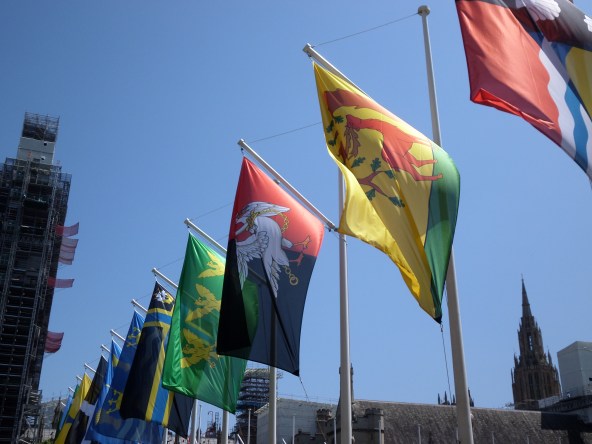
on July 23rd 2019, Historic County Flags Day #countyflagsday
Thanks to Brady Ells for his extensive research in this account.
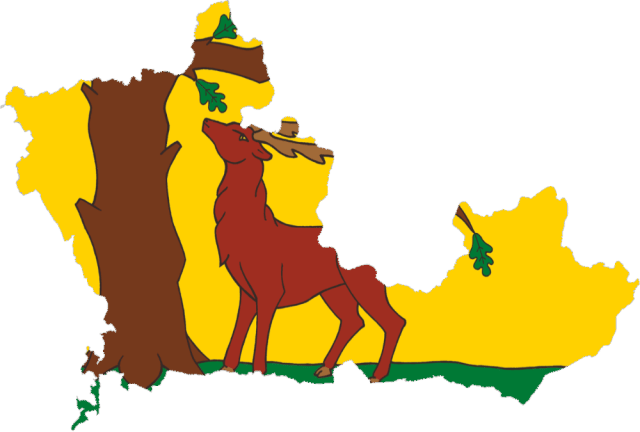

Useful Links























